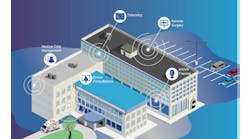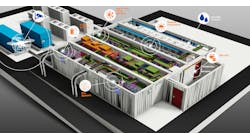Robots and drones and autonomous cars are coming, and they’ll need low-latency connectivity and lots of data storage. What might that infrastructure look like?
Austin startup Hangar Technology has teamed with edge data center provider Vapor IO to deploy an early example of infrastructure for a robot-powered world. The two companies are creating an edge computing network to manage drones as they fly missions to collect and analyze oceans of business data.
“The tens of thousands of autonomous robots being deployed by public and private organizations will require a national edge infrastructure,” said Jeff DeCoux, founder and CEO of Hangar. “As these robotics go to work, they will depend on low-latency services at the edge, including precision navigation, micro-climate decision support, and high speed ingest of data to assure safe and secure deployment.”
Vapor IO will provide the data center infrastructure through Project Volutus, a distributed network of edge colocation sites, housed in micro modular data centers that can be deployed at the base of telecom towers or other key points on the network. The Kinetic Edge is Vapor IO’s network design, which uses both wired and wireless connections to create a reliable, low-latency network of colocation sites.
Hangar operates a Robotics-as-a-System(RaaS) platform that will use Vapor IO’s Kinetic Edge connectivity for safe navigation, situational and airspace awareness, high-speed data ingest and low latency processing. Vapor’s modular data centers will also house “launch stations” where drones can park and recharge.
Drone Stations, Across the Nation
The collaboration is kicking off in Chicago, where Vapor IO is deploying its initial Project Volutus sites and Kinetic Edge network design. “We have been working with Vapor IO for over a year and are confident that the Kinetic Edge will meet our needs now and into the future,” said DeCoux.
Hangar plans to expand its network along with Project Volutus, which is backed by Crown Castle, a tower operator with more than 40,000 wireless sites across the U.S. Vapor IO plans to deploy 27 Kinetic Edge nodes by year end, with 100 more to follow in 2019.
Each unit can be equipped with a drone-sized garage that sits atop the Vapor Edge Module data center. The garage protects the drone when it’s not flying and also provides housing for the charging station and data connections. When the drone begins a mission, the garage doors open automatically and the drone leaves its station. When the drone returns, the garage doors once again open, allowing the drone to land in the garage, offload data and receive a battery charge prior to its next mission.
A Hangar drone hovering in front of the Vapor Edge Module. (Image: Hangar)
Cole Crawford, the founder and CEO of Vapor IO, says the Hangar deployment demonstrates the critical role of edge computing in advancing next-generation technologies.
“Combining Hangar’s technology with Vapor IO’s Kinetic Edge will create a nationwide footprint for completely autonomous drone missions, paving the way to deliver critical infrastructure for all types autonomous vehicles, not just drones, but also cars and trucks,” said Crawford. ““Hangar has run hundreds of thousands of drone missions, capturing imagery for millions of objects. They are the de facto standard for autonomous drone deployments.”
Hangar’s drone system is used to plan and execute drone flights that collect visual data, which is used to create digital models of structures.
“Drones are really valuable today on construction and infrastructure projects,” said DeCoux. “Drones are collecting 60 to 100 gigabytes of data per day, and getting that data back into the cloud is becoming an issue.”
BigData Takes to the Skies
In Chicago, the Hangar drones are able to offload hundreds of gigabytes of data to gear in a Vapor IO module. In addition to the data collected by cameras and sensors, drones also generate data through navigation systems, which must provide precise location data as they operate in areas near people and aviation.
“Precision navigation requires a tremendous amount of compute at the edge,” said DeCoux. “Imagine a drone inspecting a building in New York City. You need to know exactly where that drone actually is located. Precision navigation requires a tremendous amount of compute at the edge.”
The compute requirements of industrial drones were illustrated in a recent collaboration between NVIDIA and Avitas Systems, which uses drones to provide automated safety inspections of oil and gas facilities. The data-crunching for that project was supplied by an NVIDIA DGX Station, a desktop-sized supercomputer loaded with NVIDIA graphics processing units (GPUs).
Hangar uses a different network-centric model, gathering data and importing it into its cloud infrastructure, which uses computing horsepower to produce 4D visual models that can be viewed on devices ranging from tablets to virtual reality glasses.[clickToTweet tweet=”Vapor IO sees the collaboration with Hangar as the first step towards a larger network to manage an automated society.” quote=”Vapor IO sees the collaboration with Hangar as the first step towards a larger network to manage an automated society.”]
Crawford sees the collaboration with Hangar as the first step towards a larger network to manage an automated society. Hangar’s real-time tracking system is currently focused on drones, but can also be used to support autonomous cars, including precision navigation, microlocation, microclimate and universal traffic assistance. The companies plan to leverage infrastructure for autonomous robotics across the entire network of Project Volutus cities as they come online.
Vapor IO envisions its network as a key building block in the emergence of smart cities, which are tied together by devices and systems that share data in real time. Autonomous vehicles are a key piece of that vision, including data streams for vehicle-to-vehicle (V2V) and vehicle-to-infrastructure (V2I) communications.
This video from Hangar offers a vision of this future smart city:
“By offering a single, shared and open infrastructure to support any number of autonomous devices – not just drones, but also cars, trucks – the Kinetic Edge will attract a diverse ecosystem of suppliers and consumers of shared autonomous services,” Vapor IO said.
Vapor IO’s modular data center packs 150kW of compute into an enclosure, mounting its round Vapor Chamber rack enclosure on a motorized turntable. Vapor IO’s Kinetic Edge uses software and high-speed connectivity to bring multiple micro data center facilities into a single virtual facility with multiple availability zones. Modules are meshed together with high-speed fiber across a group of data centers. The design builds upon the “availability zone” approach popularized by Amazon Web Services, creating a cluster of local data centers to easily hand off data and traffic.
Vapor IO is just one of a group of startups targeting the market for edge computing, which moves content closer to users, improving the experience for streaming video and gaming. It’s a hot trend, as the emergence of the Internet of Things, AI and autonomous cars reinforces the need for data centers in new places. Other players in this space include EdgeMicro, DartPoints, DataBank, Baselayer and Switch.
Explore the evolving world of edge computing further through Data Center Frontier’s special report series and ongoing coverage.






